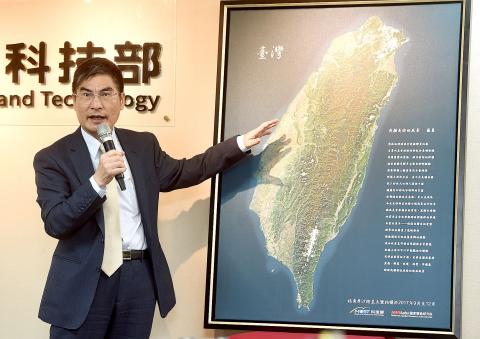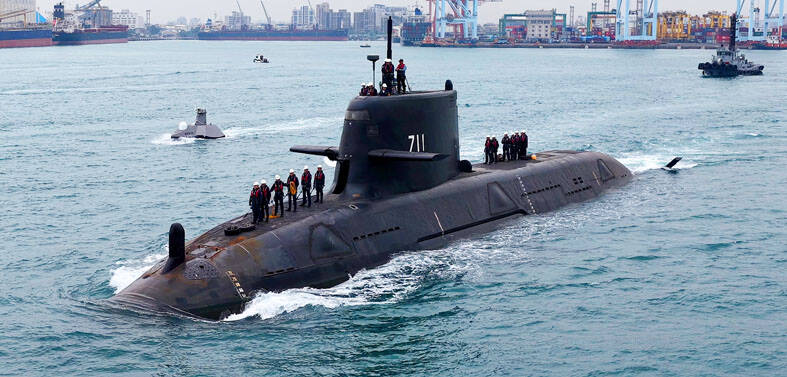The nation’s first domestically developed satellite, Formosat-5, has taken images at the resolution it was designed to deliver, but only “when weather conditions are good,” Ministry of Science and Technology (MOST) officials said yesterday, adding it has completed its mission of capturing satellite images of Taiwan.
The satellite was launched from Vandenberg Air Force Base in California on Aug. 25 last year, but the first images it transmitted back in September last year were fuzzy and marred by light spots.
Since then, the National Space Organization (NSPO) has been working to improve its image quality using image processing software and by adjusting the satellite’s altitude, angle and the temperature of its imaging device.

Photo: Chien Jung-fong, Taipei Times
At a news conference in Taipei yesterday, project director Chang Ho-pen (張和本) said the satellite has achieved the resolution it was designed to produce — 2m for black-and-white images and 4m for color images — when the weather permits.
“For example, the satellite images taken from above China and from above California can be very different when the former has serious air pollution,” Chang said.
Yet, the NSPO has not quantified what weather conditions would allow the satellite to transmit images at its default resolution, he added.

Photo: Chien Jung-fong, Taipei Times
The satellite’s images have already proven sufficient in supporting the nation’s disaster prevention missions, and would be available on the organization’s Web site from September, he said, adding that the US, Japan, Russia and Australia have expressed an interest in purchasing the images.
Asked if Formosat-5’s performance has achieved the ministry’s objectives, Chang said “yes,” while Minister of Science and Technology Chen Liang-gee (陳良基) gave a more reserved response.
The imaging capabilities of Formosate-5 have surpassed those of Formosat-2, which has a 2m resolution for monochromatic images and 8m for colored ones, Chen said.
However, when compared with the US Army’s stricter requirements, it only achieves a 3m resolution for black-and-white images and 5m for colored ones, he said.
As the NSPO is planning to launch one satellite per year in the following 10 years, it will pay more attention to the mechanical adjustment and microwave sensing capabilities of satellites, Chen said.
Meanwhile, Formosat-5, which passes over the same spot on Earth every two days, has finished taking remote images of Taiwan during its orbits between September and December last year, he said.
The ministry presented a complete satellite image of Taiwan to President Tsai Ing-wen (蔡英文) yesterday, with Tsai promising to support its space programs, Chen added.

US climber Alex Honnold is to attempt to scale Taipei 101 without a rope and harness in a live Netflix special on Jan. 24, the streaming platform announced on Wednesday. Accounting for the time difference, the two-hour broadcast of Honnold’s climb, called Skyscraper Live, is to air on Jan. 23 in the US, Netflix said in a statement. Honnold, 40, was the first person ever to free solo climb the 900m El Capitan rock formation in Yosemite National Park — a feat that was recorded and later made into the 2018 documentary film Free Solo. Netflix previewed Skyscraper Live in October, after videos

NUMBERS IMBALANCE: More than 4 million Taiwanese have visited China this year, while only about half a million Chinese have visited here Beijing has yet to respond to Taiwan’s requests for negotiation over matters related to the recovery of cross-strait tourism, the Tourism Administration said yesterday. Taiwan’s tourism authority issued the statement after Chinese-language daily the China Times reported yesterday that the government’s policy of banning group tours to China does not stop Taiwanese from visiting the country. As of October, more than 4.2 million had traveled to China this year, exceeding last year. Beijing estimated the number of Taiwanese tourists in China could reach 4.5 million this year. By contrast, only 500,000 Chinese tourists are expected in Taiwan, the report said. The report

Temperatures are forecast to drop steadily as a continental cold air mass moves across Taiwan, with some areas also likely to see heavy rainfall, the Central Weather Administration (CWA) said. From today through early tomorrow, a cold air mass would keep temperatures low across central and northern Taiwan, and the eastern half of Taiwan proper, with isolated brief showers forecast along Keelung’s north coast, Taipei and New Taipei City’s mountainous areas and eastern Taiwan, it said. Lows of 11°C to 15°C are forecast in central and northern Taiwan, Yilan County, and the outlying Kinmen and Lienchiang (Matsu) counties, and 14°C to 17°C

STEERING FAILURE: The first boat of its class is experiencing teething issues as it readies for acceptance by the navy, according to a recent story about rudder failure The Hai Kun (海鯤), the nation’s first locally built submarine, allegedly suffered a total failure of stern hydraulic systems during the second round of sea acceptance trials on June 26, and sailors were forced to manually operate the X-rudder to turn the submarine and return to port, news Web site Mirror Daily reported yesterday. The report said that tugboats following the Hai Kun assisted the submarine in avoiding collisions with other ships due to the X-rudder malfunctioning. At the time of the report, the submarine had completed its trials and was scheduled to begin diving and surfacing tests in shallow areas. The X-rudder,